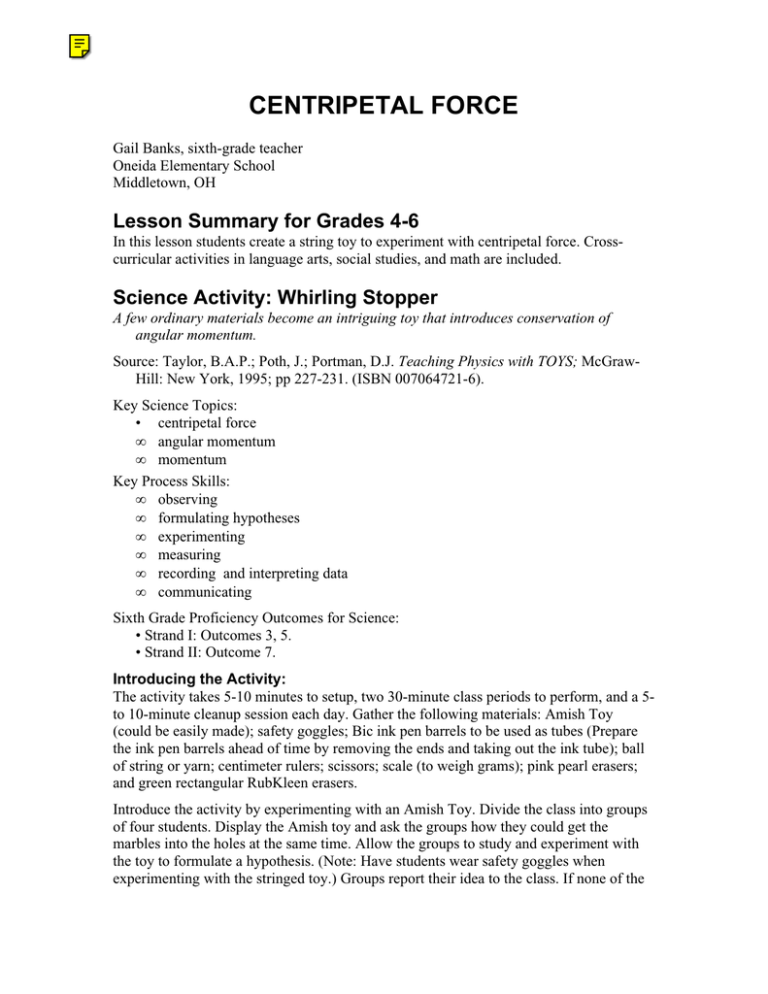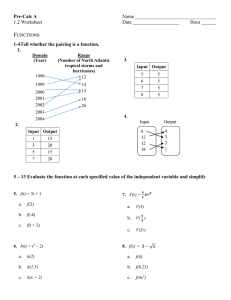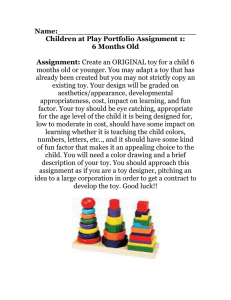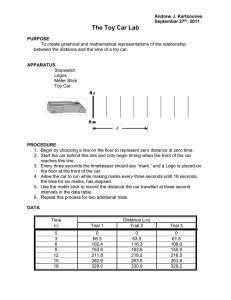centripetal force - Terrific Science
advertisement

CENTRIPETAL FORCE Gail Banks, sixth-grade teacher Oneida Elementary School Middletown, OH Lesson Summary for Grades 4-6 In this lesson students create a string toy to experiment with centripetal force. Crosscurricular activities in language arts, social studies, and math are included. Science Activity: Whirling Stopper A few ordinary materials become an intriguing toy that introduces conservation of angular momentum. Source: Taylor, B.A.P.; Poth, J.; Portman, D.J. Teaching Physics with TOYS; McGrawHill: New York, 1995; pp 227-231. (ISBN 007064721-6). Key Science Topics: • centripetal force • angular momentum • momentum Key Process Skills: • observing • formulating hypotheses • experimenting • measuring • recording and interpreting data • communicating Sixth Grade Proficiency Outcomes for Science: • Strand I: Outcomes 3, 5. • Strand II: Outcome 7. Introducing the Activity: The activity takes 5-10 minutes to setup, two 30-minute class periods to perform, and a 5to 10-minute cleanup session each day. Gather the following materials: Amish Toy (could be easily made); safety goggles; Bic ink pen barrels to be used as tubes (Prepare the ink pen barrels ahead of time by removing the ends and taking out the ink tube); ball of string or yarn; centimeter rulers; scissors; scale (to weigh grams); pink pearl erasers; and green rectangular RubKleen erasers. Introduce the activity by experimenting with an Amish Toy. Divide the class into groups of four students. Display the Amish toy and ask the groups how they could get the marbles into the holes at the same time. Allow the groups to study and experiment with the toy to formulate a hypothesis. (Note: Have students wear safety goggles when experimenting with the stringed toy.) Groups report their idea to the class. If none of the groups discover the method, demonstrate the toy by spinning it and stopping it by placing your finger in the top middle of the toy. Ask the groups if they know what force was used (centripetal force). Activity Procedure: 1. Each group has a recorder, reporter, materials handler, and timekeeper. The materials handler for each group gets the ruler, string, scissors, one ink barrel, and two pink pearl erasers or two green rectangular erasers. 2. Each group weighs their erasers using grams before beginning and records the weight. 3. Groups cut a string 3/4 meter long and convert the length to centimeters and inches, recording all three lengths. 4. Each group threads the string through the tube and ties one eraser to each end of the string (they make one toy using two pink pearl erasers together or two green rectangular erasers together). 5. Take groups outside to experiment with their toys. Note: Students should wear safety goggles when experimenting with the stringed toy. 6. When outside the groups have one person hold onto the ink barrel and swing the erasers around in a circle, while the other members of the group make observations. 7. The groups answer the following questions after making their observations to report their findings: a. What energy does the toy have before being rotated? b. What type of energy does the toy have while being rotated? c. What creates the force? What type of force is created? d. What will happen if the string breaks? e. What happens to the lower weight when the speed of rotation is increased? f. What happens to the lower weight when the speed of rotation is decreased? g. What happens to the upper weight when the speed of rotation is increased? h. Whap happens to the upper weight when the speed of rotation is decreased? i. Predict what you think will happen if you increase just the lower weight? Predict what you think will happen if you increase just the upper weight? Variations: Add additional weights to the top and then the bottom and/or shorten the length of the tube. Explanation: An eraser or other object tied to a string and twirled in a circular path tends to move in a straight line, but because of the force of the string acting upon the object its path will constantly be changed to move in a circle. All objects that move in a circular path have centripetal force acting upon them. Newton's first law of motion states that an object at rest tends to remain at rest and an object in motion tends to remain in motion at the same speed and in the same direction unless an outside force acts it upon. The tendency of the eraser to continue to move in a straight line and at the same speed is called inertia. Because the string holds the eraser back from doing this, the string has overcome the inertia of the eraser by exerting centripetal force. Centripetal force is the force that tends to pull an object toward the center of rotation. Language Arts Activity 1 Students write a personal narrative. Have students write a personal narrative about a time when they went to an amusement park and rode a ride that used centripetal force. Encourage them to say whether it was scary and their reaction during and after the ride. Sixth Grade Proficiency Outcomes for Writing: • Strands I, II, III, IV: Outcomes 1-8. Language Arts Activity 2 Students read a book and write a story summary. In a reading center have a copy of The Berenstain Bears Ride Thunderbolt. Tell students that when their other work is done they are to go to the center, read the book, and write a summary of the story. Sixth Grade Proficiency Outcomes for Reading: • Strand I: Outcome 6. Sixth Grade Proficiency Outcomes for Writing: • Strands I, II, III, IV: Outcomes 1-8. Social Studies Activity Students plot the longitude and latitude of cities. The students use a map to plot the longitude and latitude of various cities that have wellknown amusement parks, including: • Cincinnati, Ohio - Kings Island • Richmond, Virginia - Kings Dominion • Houston, Texas - Astroworld • Los Angeles, California - Disneyland • Orlando, Florida - Disney World • Dallas, Texas - Six Flags • Gatlinburg, Tennessee - Dollywood Sixth Grade Proficiency Outcomes for Citizenship: • Strand III: Outcome 8a. Math Activity Students use the metric system and construct a data sheet. The groups measure the string when constructing their toy using 3/4 meter converted to centimeters and then inches. The groups weigh the erasers using grams. The groups will construct a data sheet of their information. After experimenting the groups compare their data. Sixth Grade Proficiency Outcomes for Math: • Strand VI: Outcome 17. • Strand VIII: Outcome 22. References Berenstain, Jan and Stan. The Berenstain Bears Ride the Thunderbolt; Random House: New York, 1998. (ISBN 0679887180) Tolman, Marvin N. Hands-on Physical Science Activities for Grades K-8; Parker: West Nyack, NY, 1995. (ISBN 0132301784)


